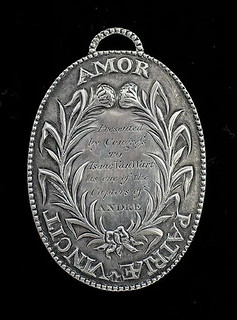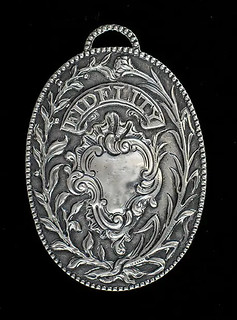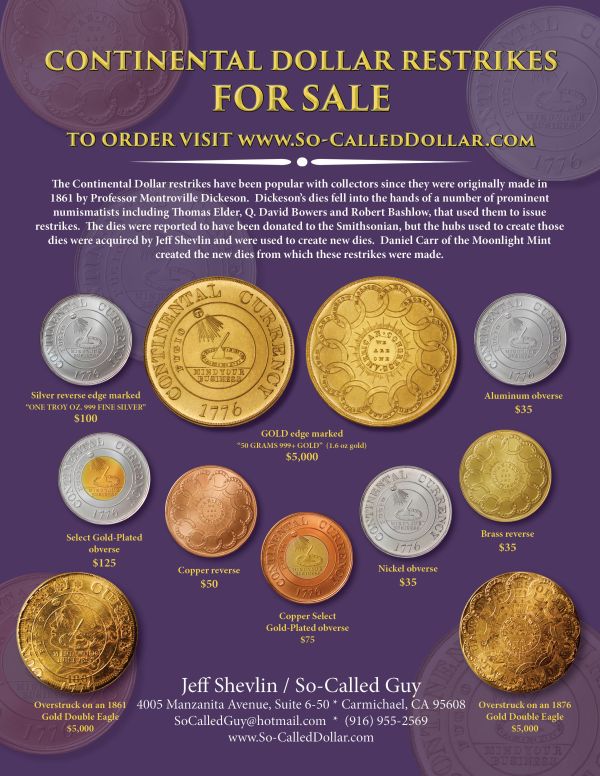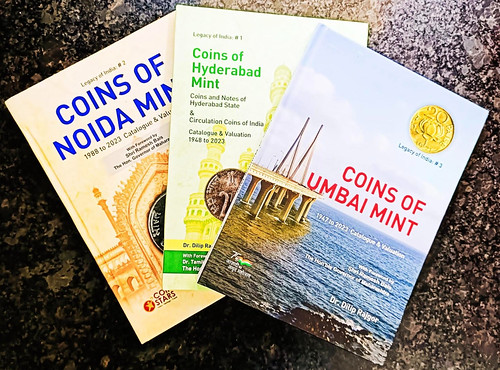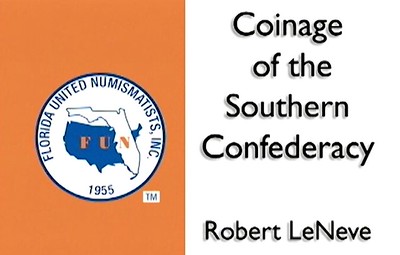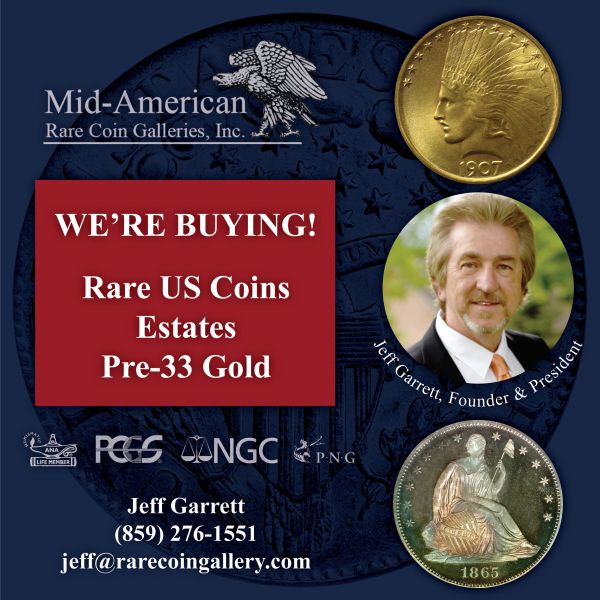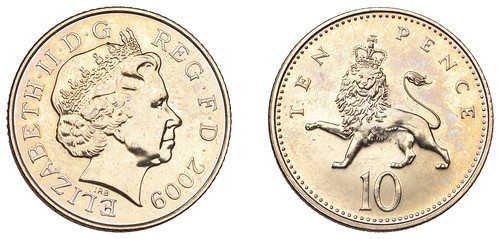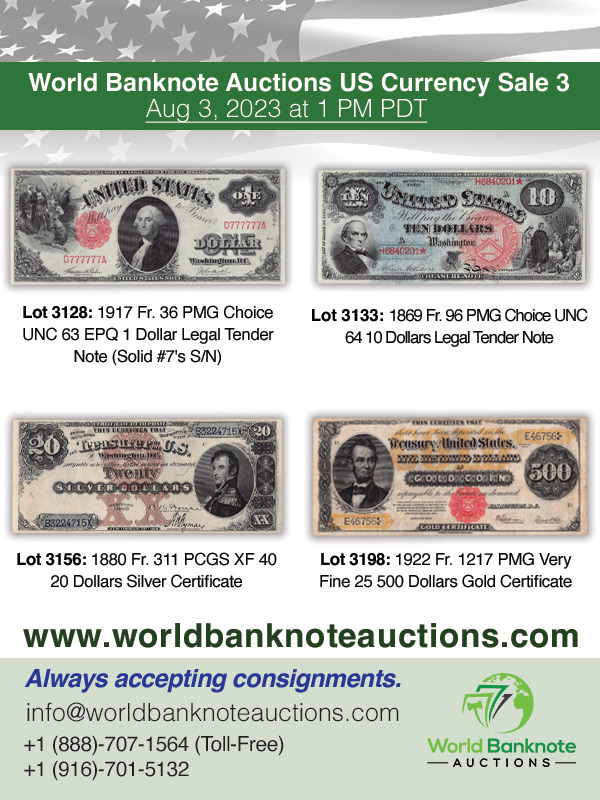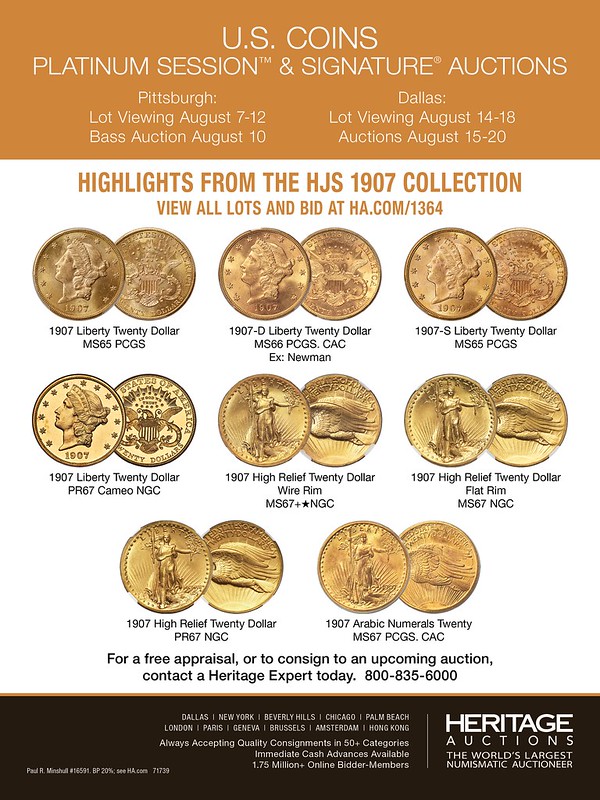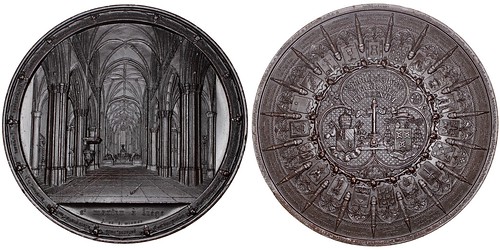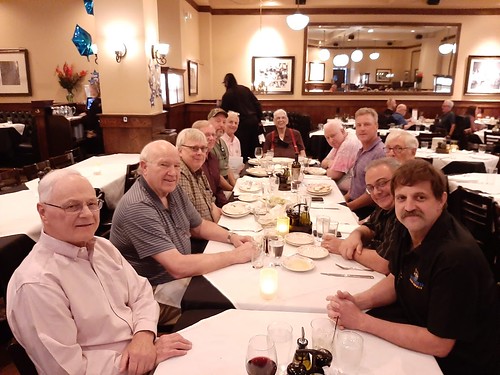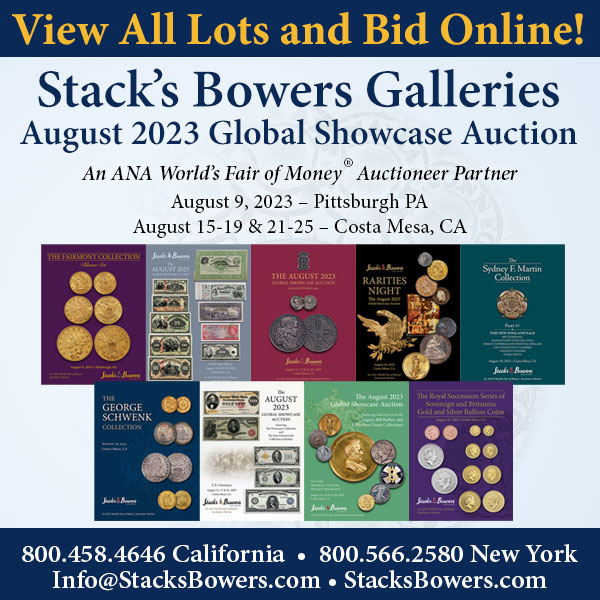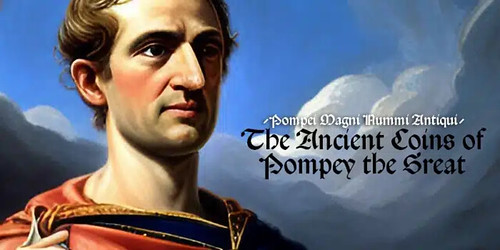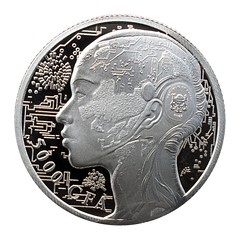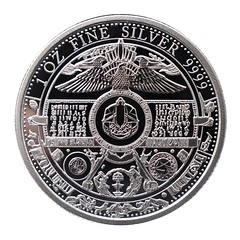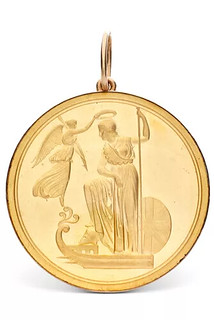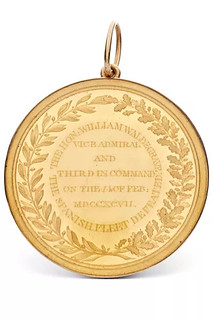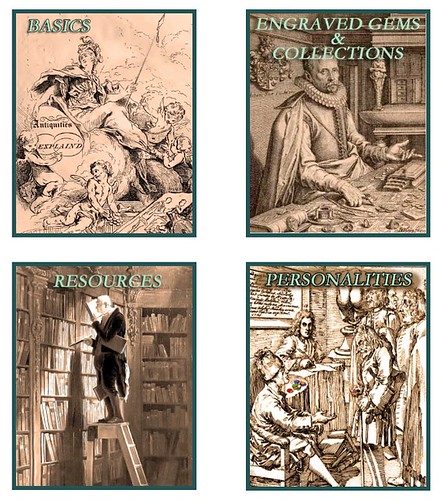
Visit our NBS Sponsors




About UsThe Numismatic Bibliomania Society is a non-profit association devoted to the study and enjoyment of numismatic literature. For more information please see our web site at coinbooks.org SubscriptionsThose wishing to become new E-Sylum subscribers (or wishing to Unsubscribe) can go to the following web page link MembershipThere is a membership application available on the web site Membership Application To join, print the application and return it with your check to the address printed on the application. Print/Digital membership is $40 to addresses in the U.S., and $60 elsewhere. A digital-only membership is available for $25. For those without web access, write to: Charles Heck, Treasurer AsylumFor Asylum mailing address changes and other membership questions, contact Chuck at this email address: treasurer@coinbooks.org SubmissionsTo submit items for publication in The E-Sylum, write to the Editor at this address: whomren@gmail.com BUY THE BOOK BEFORE THE COINSale Calendar |
- WAYNE'S WORDS: THE E-SYLUM JULY 23, 2023
- NBS BOOKBINDING DEMO: MARBLED PAPER
- ANS SUMMER BOOK SALE!
- NEW BOOK: MEGA RED 9TH EDITION
- NEW BOOK: U.S. TREASURY NOTES, 1812-1865
- NEW BOOK: HISTORY OF PAPER MONEY IN PUERTO RICO, VOL I
- NEW BOOKS: COINS OF THE NOIDA AND MUMBAI MINTS
- NEW BOOKS: CHINESE, SIAMESE GAMING PIECES
- NEW BOOK: THE MEDAL IN EARLY MODERN SWEDEN
- THE RABBIT HOLE OF THE 1909 WHEAT CENT
- VIDEO: SOUTHERN CONFEDERACY COINAGE
- MUSEUM ACQUIRES VINCIT AMOR PATRIAE MEDAL
- NOTES FROM E-SYLUM READERS: JULY 23, 2023
- ELIZABETH CAMPBELL'S NAILS TO NICKELS
- THE 2009 TEN PENCE MULE ERROR
- TASSIE COIN IMPRESSIONS
- HIGGINS MUSEUM COIN AND BANK BAGS
- VOCABULARY TERM: NEGATIVE SHADOW
- GENE HESSLER TURNS 95
- MIKE DIAMOND INTERVIEW, PART ONE
- THOMAS HIPSCHEN: FACE VALUE
- BEN FRANKLIN'S MONEY PRINTING TECHNIQUES
- INTERVIEW: EASY MONEY AUTHOR DROR GOLDBERG
- BOB FRITSCH, NEWEST KNIGHT OF ST. ELIGIUS
- NUMISMAGRAM MEDAL SELECTIONS: JULY 23, 2023
- WAYNE'S NUMISMATIC DIARY: JULY 23, 2023
- CELTIC GOLD HOARD THEFT ARRESTS
- HOARD COINS SWITCHED FOR BETTER EXAMPLES
- THE ANCIENT COINS OF POMPEY THE GREAT
- PRESSBURG MINT ISSUES AI-DESIGNED BULLION COIN
- ADMIRAL WILLIAM WALDEGRAVE'S VICTORY MEDAL
- FEATURED WEBSITE: THE ENGRAVED GEM
Click here to read the thin version on the web
Click here to subscribe
Click here to access the complete archive
To comment or submit articles, reply to whomren@gmail.com
Content presented in The E-Sylum is not necessarily researched or independently fact-checked, and views expressed do not necessarily represent those of the Numismatic Bibliomania Society.
WAYNE'S WORDS: THE E-SYLUM JULY 23, 2023
 New subscribers this week include:
Shawn Tew and Don Goddeau.
Welcome aboard! We now have 8,059 subscribers.
New subscribers this week include:
Shawn Tew and Don Goddeau.
Welcome aboard! We now have 8,059 subscribers.
Thank you for reading The E-Sylum. If you enjoy it, please send me the email addresses of friends you think may enjoy it as well and I'll send them a subscription. Contact me at whomren@gmail.com anytime regarding your subscription, or questions, comments or suggestions about our content.
This week we open with a book sale, eight new books, updates from the Newman Numismatic Portal, notes from readers, and more.
Other topics this week include Puerto Rican paper money, Indian coinage, Chinese and Siamese gaming pieces, the 1909 Lincoln Cent, coin and bank bags, Gene Hessler, Mike Diamond, Tom Hipschen, Ben Franklin, Beate Rauch, the Knights of St. Eligius, my numismatic diary, sad and weird coin hoard news, and a coin designed by artificial intelligence.
To learn more about marbled paper, quarter eagles, U.S. Treasury Notes, early modern Swedish medals, the Vincit Amor Patriae medal, Out-East World Coins, Nails to Nickels, James and William Tassie, muscovite, the Operation Crossroads Short Snorter, coins of Pompey the Great, and engraved gems, read on. Have a great week, everyone!
Wayne Homren
Editor, The E-Sylum
NBS BOOKBINDING DEMO: MARBLED PAPER
The Numismatic Bibliomania Society table at this summer's American Numismatic Association World's Fair of Money® will feature a special live bookbinding demonstration. Len Augsburger submitted this update. -Editor
NBS Bookbinding Demo at ANA Convention
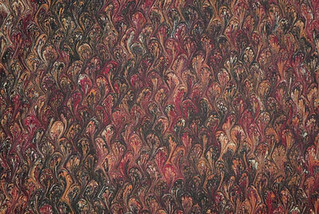 Our bookbinding term of the week is “marbled paper,” which was sometimes used in older books for the front and rear pastedowns. Wikipedia explains the manufacture: “A shallow tray is filled with water, and various kinds of ink or paint colors are carefully applied to the surface with an ink brush. Various additives or surfactant chemicals are used to help float the colors.” Once the desired pattern is achieved, a sheet of paper is pressed into the solution, and the image transfers (in reverse) to the sheet. For our demo at the ANA, we will have several types of marbled paper to choose from, such as this “French marble peacock” example.
Our bookbinding term of the week is “marbled paper,” which was sometimes used in older books for the front and rear pastedowns. Wikipedia explains the manufacture: “A shallow tray is filled with water, and various kinds of ink or paint colors are carefully applied to the surface with an ink brush. Various additives or surfactant chemicals are used to help float the colors.” Once the desired pattern is achieved, a sheet of paper is pressed into the solution, and the image transfers (in reverse) to the sheet. For our demo at the ANA, we will have several types of marbled paper to choose from, such as this “French marble peacock” example.
ANS SUMMER BOOK SALE!
The American Numismatic Society is holding a summer book sale. This is a great opportunity. Here's an abbreviated version of the full announcement. BEWARE - some of these may already be sold out by the time you read this. -Editor
Stock up for your summer reading with books from the ANS. Choose from backlist titles as well as select recent titles, some as low as $2 (plus shipping). Note that ANS member discounts are not applicable on these closeout prices.
NEW BOOK: MEGA RED 9TH EDITION
The ninth edition of Mega Red adds a section covering quarter eagle gold coins. Here's the announcement. -Editor
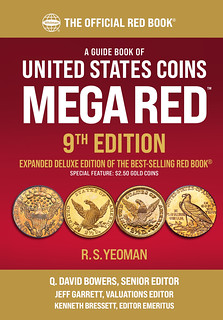 The ninth edition of Mega Red (the Deluxe Edition of the Guide Book of United States Coins) is available for sale. The 1,504-page book can be ordered online (including at Whitman.com) and is available from booksellers and hobby shops nationwide.
The ninth edition of Mega Red (the Deluxe Edition of the Guide Book of United States Coins) is available for sale. The 1,504-page book can be ordered online (including at Whitman.com) and is available from booksellers and hobby shops nationwide.
The new ninth-edition Mega Red includes updates and revisions in every U.S. coinage series. As a special feature, it includes 178 pages of expanded study of quarter eagle gold coins—the $2.50 denomination issued from 1796 to 1929. Every type, date, and mintmark of these valuable and collectible gold coins is individually studied. Coverage includes history, illustrated grading standards, mintage information (including for rare early Proofs), strike characteristics, data on logotypes and other die characteristics, estimated field populations in Mint State and circulated grades, collectible die varieties, selected historical auction records, and more. This in-depth analysis covers all eight major quarter eagle types from the Capped Bust coins of the 1790s to the Indian Head coinage that concluded just before the Great Depression.
More than a dozen appendices explore specialized subjects such as patterns, error and misstruck coins, and counterfeits. One richly illustrated 43-page appendix, based on the work of Q. David Bowers and Katherine Jaeger, studies the history and collecting of American medals and tokens. Another in-depth appendix covers the American Arts Commemorative Series gold medallions of 1980 to 1984. Numismatists Jeff Shevlin and William D. Hyder contributed an 18-page study of So-Called Dollars with photographs, historical information, rarity data, and values for nearly 100 different examples struck to celebrate expositions of the 1880s. Other appendices describe the United States Mint’s upcoming coinage programs for 2024 and beyond.
NEW BOOK: U.S. TREASURY NOTES, 1812-1865
Last week we published a couple excerpts from the new book by Nicholas J. Bruyer on U.S. Treasury Notes. Here's the full announcement from publisher Stack's Bowers. -Editor
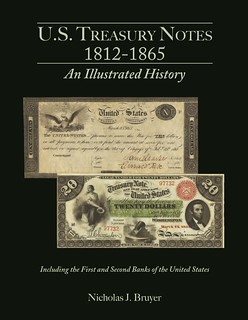 A fresh perspective on the history of United States paper money arrives with Stack’s Bowers
Galleries’ publication of United States Treasury Notes 1812-1865: An Illustrated History, by Nicholas J. Bruyer.
Bridging the gap between the Continental Currency of the Revolutionary War and the paper money issued by the
United States to fund the Civil War, the 271-page hard cover book chronicles how the Treasury repeatedly used
Treasury notes as a form of national currency in its times of greatest need.
A fresh perspective on the history of United States paper money arrives with Stack’s Bowers
Galleries’ publication of United States Treasury Notes 1812-1865: An Illustrated History, by Nicholas J. Bruyer.
Bridging the gap between the Continental Currency of the Revolutionary War and the paper money issued by the
United States to fund the Civil War, the 271-page hard cover book chronicles how the Treasury repeatedly used
Treasury notes as a form of national currency in its times of greatest need.
Peter Treglia, Director of Currency at Stack’s Bowers Galleries stated "Nicholas J. Bruyer's insightful book not only sheds light on the importance of various types and issues of currency, but it also unravels the mysteries that collectors and scholars have long pondered. With meticulous research and a keen eye for detail, Bruyer masterfully connects the dots, providing the answers to longstanding questions. From the earliest days of U.S. issued Treasury Notes to the Civil War, this book serves as a definitive resource, furthering our understanding of our nation's monetary heritage. Prepare to embark on an enlightening journey as Bruyer weaves together the threads of history, offering profound insights and a newfound appreciation for the importance of early US Treasury Notes.”
NEW BOOK: HISTORY OF PAPER MONEY IN PUERTO RICO, VOL I
Ángel Navarro Zayas has published a new documentary history (in Spanish) of paper money in Puerto Rico. Here's a Google translation from the publisher's website. -Editor
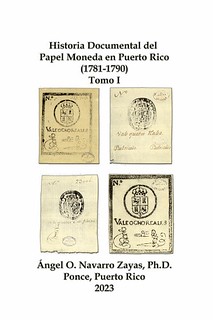 Historia Documental del Papel Moneda en Puerto Rico (1781-1790) Tomo I
Historia Documental del Papel Moneda en Puerto Rico (1781-1790) Tomo I
By
Ángel Navarro Zayas
Documentary History of Paper Money in Puerto Rico (1781-1790) Volume I
This Documentary History of Paper Money in Puerto Rico (1781-1790), Volume I, constitutes the beginning of a new series of volumes through which its author, the dynamic historian and young university professor, Dr. Ángel O. Navarro Zayas, will enrich his already extensive and constant bibliographic production within the subject of the study of the monetary and numismatic history of Puerto Rico. These achievements constitute the most prolific, useful, and relevant that a scholar in any of these fields has ever achieved, up to now, within Puerto Rican historiography.
NEW BOOKS: COINS OF THE NOIDA AND MUMBAI MINTS
Pabitra Saha alerted me to two new books by Dr. Dilip Rajgor in his Legacy of India series: Coins of Noida Mint 1988 to 2023 Catalogue & Valuation and Coins of Mumbai Mint 1947 to 2023 Catalogue & Valuation. Thank you. I found some additional information online. We discussed the first book in the series back in April. -Editor
NEW BOOKS: CHINESE, SIAMESE GAMING PIECES
David Hartill has also published a couple new books on gaming pieces that we haven't discussed yet. See the link below for his earlier book on Chinese amulets. -Editor
Cast Chinese Gaming Pieces
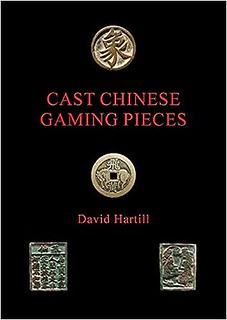 Various classes of objects were omitted from “Cast Chinese Amulets” (by this author), as their primary use was for gaming, rather than the bringing of good fortune. This book is intended to make good this omission. The pieces covered are:
Various classes of objects were omitted from “Cast Chinese Amulets” (by this author), as their primary use was for gaming, rather than the bringing of good fortune. This book is intended to make good this omission. The pieces covered are:
Horse Coins, a Song Dynasty game played with counters bearing the names of famous horses and generals.
Chess Pieces, the well-known game of Chinese Chess, still played to this day.
Select An Immortal. A game played during the Song dynasty using counters with illustrations of one of the Immortals, and a short poem describing their activities.
Wine Drinking Game Coins. These are counters dating back to the time of the Han dynasty, and were used for a variety of drinking games.
Study of these pieces gives an insight to Chinese history and traditions; full details of this are given for each piece.
Publisher : New Generation Publishing (March 18, 2022)
Language : English
Paperback : 123 pages
ISBN-10 : 1803693185
ISBN-13 : 978-1803693187
Item Weight : 11.2 ounces
Dimensions : 8.27 x 0.28 x 11.69 inches
NEW BOOK: THE MEDAL IN EARLY MODERN SWEDEN
This one was published in 2021, but I just came across it this week. And since we had fun with this before, can anyone tell us more about the painting on the book's cover? -Editor
The Medal in Early Modern Sweden
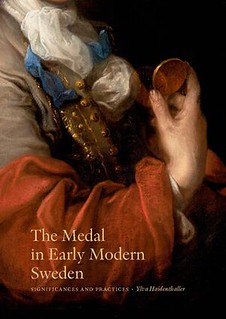 From the Renaissance and onwards, the medal has been an important element of European art and visual culture. It was appreciated for its symbolic and material value. However, much of its significance lies in the fact that it affects multiple senses and not sight alone. Recipients can touch and hold it, wear it, trace the engraved portrait with their fingers, or place it in a cabinet drawer. How people engaged with medals and which significance this medium gained and lost unearths how visual media and early modern art were used over time. From the 16th to the 18th century, the medal changes shapes and meanings, inspires and assumes tendencies from other visual expressions, and one can trace European culture and politics through it.
From the Renaissance and onwards, the medal has been an important element of European art and visual culture. It was appreciated for its symbolic and material value. However, much of its significance lies in the fact that it affects multiple senses and not sight alone. Recipients can touch and hold it, wear it, trace the engraved portrait with their fingers, or place it in a cabinet drawer. How people engaged with medals and which significance this medium gained and lost unearths how visual media and early modern art were used over time. From the 16th to the 18th century, the medal changes shapes and meanings, inspires and assumes tendencies from other visual expressions, and one can trace European culture and politics through it.
THE RABBIT HOLE OF THE 1909 WHEAT CENT
The latest addition to the Newman Numismatic Portal is a new study on varieties of the 1909 and 1910 Lincoln Cent. Project Coordinator Len Augsburger provided the following report. -Editor
An Exploration of 1909 and 1910 Lincoln Cent Varieties
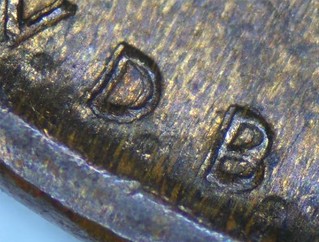 Recently added to the Newman Portal is Shawn Tew’s The Rabbit Hole of the 1909 Wheat Cent, a work supported in part by a grant from the Eric P. Newman Numismatic Education Society. In this work, Tew synthesizes the current technical research related to this coin and uses material from the National Archives to provide context for the design changes made early in the life of the Lincoln cent, the most ubiquitous coin in recorded history.
Recently added to the Newman Portal is Shawn Tew’s The Rabbit Hole of the 1909 Wheat Cent, a work supported in part by a grant from the Eric P. Newman Numismatic Education Society. In this work, Tew synthesizes the current technical research related to this coin and uses material from the National Archives to provide context for the design changes made early in the life of the Lincoln cent, the most ubiquitous coin in recorded history.
The interplay between Victor D. Brenner and Charles Barber is fascinating, as the efforts to bring artistry to the nation’s coinage come into conflict with the quotidian concerns of day-to-day coinage production. Tew summarizes the known varieties for the 1909 and 1910 cents, one of which reuses a reverse from 1909. Tew leaves no stone unturned and integrates test results from the Center for Advanced Microscopy at Michigan State University, in order to analyze the relief profiles of the reverse dies. The work concludes with analysis of a remarkable hoard of Lincoln cents put away in 1909 and not fully examined until today.
VIDEO: SOUTHERN CONFEDERACY COINAGE
The David Lisot Video Library on the Newman Numismatic Portal can be found at:
https://nnp.wustl.edu/library/multimediadetail/522852
We highlight one of his videos each week in The E-Sylum. Here's one from 2007 about coinage of the Southern Confederacy. -Editor
MUSEUM ACQUIRES VINCIT AMOR PATRIAE MEDAL
A rare early U.S. military medal connected to the treason of Benedict Arnold has been donated to the New York State Museum. Thanks to Stephen Searle and Arthur Shippee for passing along this New York Times article. Here's an excerpt - see the complete article online. -Editor
The American militia men were hidden in the bushes having lunch and playing cards when they heard the horse galloping toward them. Springing from their lookout post near Tarrytown, N.Y., they confronted a stranger who was seemingly in a great hurry.
He was Maj. John André, head of British secret intelligence. But on this day, Sept. 23, 1780, he was disguised as a civilian, “John Anderson.”
Stuffed in André’s boot were papers that laid out how to successfully take the American fort at West Point. He had only received the information two days earlier from Benedict Arnold, the commander of the fort, and André now was riding south in the hope of getting back behind the British lines.
THE BOOK BAZARRE
NOTES FROM E-SYLUM READERS: JULY 23, 2023
Beate Rauch at 93
Beate Rauch writes:
"Beate Rauch is still alive, 93 years old but still alive. Keep up the good works."
Great to hear! -Editor
To read the earlier E-Sylum article, see:
NOTES FROM E-SYLUM READERS: JULY 16, 2023 : Beate Rauch: Still With Us
(https://www.coinbooks.org/v26/esylum_v26n29a13.html)
Other topics this week include the Medal Collectors of America, and Out-East World Coins. -Editor
ELIZABETH CAMPBELL'S NAILS TO NICKELS
Julia Casey submitted this nice piece on how author Elizabeth Campbell got the idea for her book Nails to Nickels. Thanks! I wasn't aware of this background. -Editor
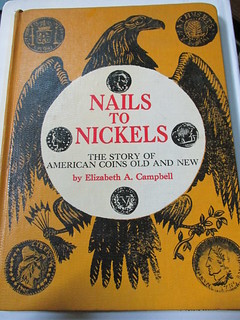 My mother passed away last year. My siblings and I are still going through all the stuff stashed away at her house. I came across a box called "Julia's Books" and in it, I found a copy of "Nails to Nickels." I don't remember this book as a child but I love it that my mother packed it away for me. I have five older siblings and this book predates me (it's a first edition) so it could have belonged to any one of them first, but my mother made sure it got to me.
My mother passed away last year. My siblings and I are still going through all the stuff stashed away at her house. I came across a box called "Julia's Books" and in it, I found a copy of "Nails to Nickels." I don't remember this book as a child but I love it that my mother packed it away for me. I have five older siblings and this book predates me (it's a first edition) so it could have belonged to any one of them first, but my mother made sure it got to me.
It's a wonderful children's book! I'm impressed that the author was so comprehensive in the story.
I found a newspaper article from the June 30, 1960 Norfolk Ledger-Dispatch that relates how Elizabeth Campbell got the idea for the book.
THE 2009 TEN PENCE MULE ERROR
Eric G. Dawson submitted these notes on the 2009 Ten Pence mule error. -Editor
I'm curious to learn more about an extremely rare 2009 Great Britain currency 10 pence. Evidently there are only 2 or three known pieces making it arguably the rarest decimal coin struck. It was sold in the Noonan's Auction of 7-8 June, 2023 as Lot #508 and fetched 1300 pounds plus the commission.
As a collector of British coins (mainly late predecimal milled copper and silver) I found this coin interesting and could find precious little about it except for an additional specimen sold by London Coins in 2015. I don't believe it has been formally published.
TASSIE COIN IMPRESSIONS
Don Goddeau submitted this note about the coin impressions of James and William Tassie. -Editor
First, I want to say how pleased I am to find a real person to ask a question about numismatics. It’s not my field, except tangentially, and I have been looking for someone with a broad knowledge of the field to ask a question of – you seem to fit the description.
Second, a little background about how I found you and an answer to a question you asked sixteen years ago. While surfing the web looking for all things “Nathaniel Marchant”, I came across your diary entry of 7 Aug 2007 in which you described your visit to the Soane Museum in London. You saw the portrait of Marchant labeled, “Nathaniel Marchant R.A. Die Sinker To the MINT" and asked, “Was he an engraver at the Royal Mint?” The short answer is found in Seidmann’s article (which you mention) ’NATHANIEL MARCHANT, GEM-ENGRAVER 1739-1816', Walpole Society, vol. LIII, 1987, pp. 1-105. By G. Seidmann, It can be found and downloaded at https://www.jstor.org/stable/pdf/41829502.pdf (There is a charge unless you have academic connections.)
In the article, p22, she states, “The first 'place' to which he was appointed, in 1797, was as probationer or apprentice engraver at the Mint, replacing John Milton (who had used Mint facilities for unauthorized purposes) under Pingo as Chief Engraver. In this post, and subsequently that of Assistant Engraver, performed his duties 'with diligence and fidelity', until superannuated for reasons 'age and infirmities' in 1815, only a few months before his death.”
HIGGINS MUSEUM COIN AND BANK BAGS
George Cuhaj is the curator of the Higgins Museum of National Bank Notes, and he passed along this information about coin and bank bags in the museum's collection. -Editor
You are brave for venturing into the bank bag / coin bag / deposit pouch field.
They are partly utilitarian for coin, bank notes, and document transport and storage and partly serving an advertising / customer convenience purpose.
Attached are representative photos of bags in the Higgins Museum reference collection. We have plenty of them, with litte duplication.
As to the Coin Bags, note the Federal Reserve Bank of Chicago bag formerly said Gold Coin, and from the production code 5,000 were made or ordered on April 21 1933.
VOCABULARY TERM: NEGATIVE SHADOW
Here's another entry from Dick Johnson's Encyclopedia of Coin and Medal Terminology. Interesting property of tin! -Editor
Negative Shadow. Flow marks on tin and tin alloy compositions which form a permanent bright “shadow” in contrast to the remaining surface of a struck piece which has darkened from exposure to cold temperature. Tin has this unusual property; it does not work harden like other coinage compositions. Instead, its surface displacement during striking causes the flow marks to form a permanent bright area, somewhat like bright finish on other metals. Tin, tin alloys, including white metal, will darken in time, called darkening, from a mild condition of tin pest. This darkening is brought on from another property of tin – it is unstable below 18° centigrade (64° Fahrenheit). Prolonged exposure to cold temperatures first causes this dark toning on all surfaces that do not exhibit negative shadow. Continued exposure will cause unstable metallic tin (beta-tin) changing to the stable powdery form (alpha-tin) on the surface. The darkened area is in stark contrast to the bright areas of negative shadow. See tin, white metal.
GENE HESSLER TURNS 95
E-Sylum Feature Writer and American Numismatic Biographies author Pete Smith submitted this article on researcher, author and Money Museum curator Gene Hessler. Thanks. Happy Birthday, Gene! -Editor
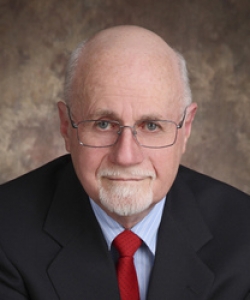 I have some great memories from the 1991 Centennial ANA Convention. At the time I was
conducting interviews for American Numismatic Biographies. On the morning of August 15, I
sat outside before the bourse opened. For about an hour I sat with John J. Ford and heard some
great stories. A few of them I was able to print.
I have some great memories from the 1991 Centennial ANA Convention. At the time I was
conducting interviews for American Numismatic Biographies. On the morning of August 15, I
sat outside before the bourse opened. For about an hour I sat with John J. Ford and heard some
great stories. A few of them I was able to print.
As the show was winding down, I walked through the exhibit area. Gene Hessler was there packing up his exhibit. I knew Gene from an interview I had done in May. At his side was the Howland Wood Memorial Award that he had won for his “Best of Show” exhibit. This was the first time I really thought about the award. Five years later I received the same award.
MIKE DIAMOND INTERVIEW, PART ONE
Separately from his interview series for the Newman Numismatic Portal, error collector Greg Bennick has been profiling experts in the error field for ErrorScope, the publication of the Combined Organization of Error Collectors of America (CONECA). Occasionally we share one with permission here in The E-Sylum. Here's the first of four parts of Greg's interview with collector and writer Mike Diamond, covering Mike's introduction to error collecting. Many thanks to Greg, ErrorScope Editor Allan Anderson, and CONECA for making this available here. -Editor
Greg Bennick: Mike, thanks for taking some time to answer some questions today. Can you tell me a little about your background?
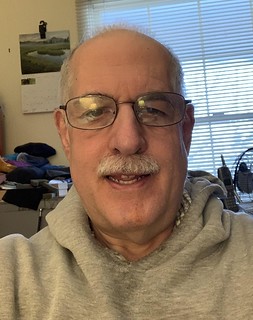 Mike Diamond: Well, I’m semi-retired now. I work as a freelance writer. I write for Coin World. I used to be a teacher, teaching biological anthropology and cultural anthropology. Before that I taught human gross anatomy and other courses necessary for basic health sciences. I have a Ph.D. in biological anthropology from the University of Chicago. Coins are a hobby that allow me to exercise my brain. I haven’t done any active scientific research for quite a while, so this keeps my neurons firing and lets me work on my writing skills, too.
Mike Diamond: Well, I’m semi-retired now. I work as a freelance writer. I write for Coin World. I used to be a teacher, teaching biological anthropology and cultural anthropology. Before that I taught human gross anatomy and other courses necessary for basic health sciences. I have a Ph.D. in biological anthropology from the University of Chicago. Coins are a hobby that allow me to exercise my brain. I haven’t done any active scientific research for quite a while, so this keeps my neurons firing and lets me work on my writing skills, too.
Greg Bennick: How did you get involved with error collecting? How and when did that come about?
Mike Diamond: I had a brief flirtation when I was in high school in the early 1970s, and quite probably it started when I picked up Frank Spadone’s terrible book on errors, which I didn’t know was terrible at the time. (Note: Major Variety and Oddity Guide of United States Coins, by Frank G. Spadone, Krause Publications, Iola WI)
THOMAS HIPSCHEN: FACE VALUE
While looking for other things (*cough* Gene Hessler) I came across this great 2010 Washingtonian article about BEP portrait engraver Tom Hipschen. -Editor
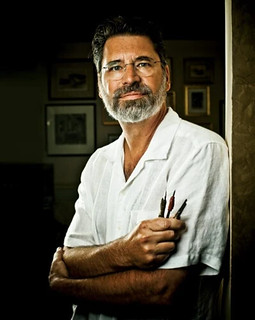 Though few Washingtonians know of him, most of us carry some of Thomas Hipschen’s art every day. His portraits of Abraham Lincoln, Andrew Jackson, Ulysses S. Grant, and Ben Franklin are cut into American history, printed on the front of the $5, $20, $50, and $100 bills.
Though few Washingtonians know of him, most of us carry some of Thomas Hipschen’s art every day. His portraits of Abraham Lincoln, Andrew Jackson, Ulysses S. Grant, and Ben Franklin are cut into American history, printed on the front of the $5, $20, $50, and $100 bills.
Hipschen is considered one of the world’s best portrait engravers. “For the late 20th century, he is basically the engraver,” says Mark D. Tomasko, author of The Feel of Steel, a history of currency engraving in the United States.
BEN FRANKLIN'S MONEY PRINTING TECHNIQUES
Speaking of the cat and mouse game between security printers and counterfeiters, a new study of Ben Franklin's paper money printing techniques is getting a lot of mainstream press. Gerry Tebben submitted these thoughts. Thanks. -Editor
The best thing about newspapers is you never know what you're going to find. The New York Times reports on a paper about Benjamin Franklin's printing techniques that was just printed in the Proceedings of the National Academy of Sciences.
The Times story says, "During his printing career, Franklin produced a stream of baroque, often beautiful money. He created a copper plate of a sage leaf to print on money to foil counterfeiters: The intricate pattern of veins could not easily be imitated. He influenced a number of other printers and experimented with producing new paper and concocting inks."
Here's a link to the Times article:
https://www.nytimes.com/2023/07/17/science/benjamin-franklin-counterfeit-currency.html
INTERVIEW: EASY MONEY AUTHOR DROR GOLDBERG
For background on the importance of colonial paper money to the developing national economy, the University of Chicago Press published a blog article interviewing Dror Goldberg, author of Easy Money: American Puritans and Invention of Modern Currency. Here's an excerpt - see the complete article online. -Editor
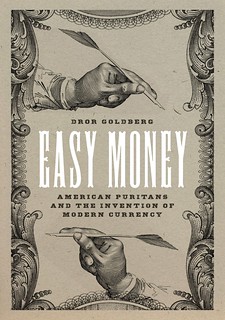 While you were working on this project, what did you learn that surprised you the most?
I was surprised to learn how interesting early American history was. As a foreign economist, without a British or Christian background, all I knew about the colonial period before starting this project was Mayflower, Thanksgiving, and the Salem witch trials.
While you were working on this project, what did you learn that surprised you the most?
I was surprised to learn how interesting early American history was. As a foreign economist, without a British or Christian background, all I knew about the colonial period before starting this project was Mayflower, Thanksgiving, and the Salem witch trials.
Later, I was surprised to learn how valuable my perspective could be, exactly because I was such a complete outsider. The subject of my investigation—a currency issued by Massachusetts in 1690—has been known to historians for centuries. The perspective of an economist (with legal training) was necessary to appreciate the global historical significance of this invention. This culturally distanced perspective allowed me to investigate and explore this history with fewer preconceived notions about England vs. America, a preference for a region within America or a Christian denomination, or a penchant for seeing everything as leading to the American Revolution.
THE BOOK BAZARRE
BOB FRITSCH, NEWEST KNIGHT OF ST. ELIGIUS
Bob Fritsch has been inducted into the St. Eligius Numismatist Brotherhood - here's the announcement. Congratulations! -Editor
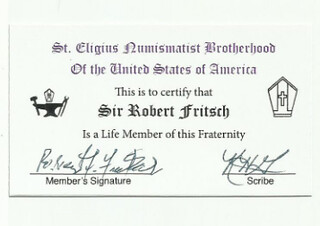 With great pleasure and honor Frank Galindo, Chancellor, St. Eligius Numismatist Brotherhood, U.S.A. (a branch of the Saint Eligius Brotherhood of Numismatists of Canada), has inducted and welcomed Robert (Bob) F. Fritsch, FRCNA, FONA as a life fraternal brother, and Knight of St. Eligius. Bob is in good company, as there are very distinguished Knights in the United States (including Puerto Rico), Canada, Germany, France, Hungary, and some other European countries, as well as some South American countries. Knights come from different professions, such as professors, doctors, scientists, business executives, educators, artists, authors, religious leaders, veterans, and retirees. One thing in common with all Knights, is their generous spirit, their advancement of numismatic education and the science of numismatics, their volunteerism, their fostering of fellowship, and their help in growing and sustaining the numismatic hobby for the enjoyment of others.
With great pleasure and honor Frank Galindo, Chancellor, St. Eligius Numismatist Brotherhood, U.S.A. (a branch of the Saint Eligius Brotherhood of Numismatists of Canada), has inducted and welcomed Robert (Bob) F. Fritsch, FRCNA, FONA as a life fraternal brother, and Knight of St. Eligius. Bob is in good company, as there are very distinguished Knights in the United States (including Puerto Rico), Canada, Germany, France, Hungary, and some other European countries, as well as some South American countries. Knights come from different professions, such as professors, doctors, scientists, business executives, educators, artists, authors, religious leaders, veterans, and retirees. One thing in common with all Knights, is their generous spirit, their advancement of numismatic education and the science of numismatics, their volunteerism, their fostering of fellowship, and their help in growing and sustaining the numismatic hobby for the enjoyment of others.
As Frank is unable to travel beyond an area in his home state of Texas, he was delighted to have other Knights present to Bob during the Royal Canadian Numismatic Association’s annual convention held in Halifax, Nova Scotia, Canada, this month.
NUMISMAGRAM MEDAL SELECTIONS: JULY 23, 2023
Numismagram's Jeremy Bostwick forwarded these four medals from his most recent addition of new material. This particular upload has an architectural theme, with many of the "Most Remarkable Edifices of Europe" series from Wiener offered. For all of this upload's newest additions, please visit https://www.numismagram.com/inventory. -Editor
102407 | BELGIUM. Liège. St. Martin's Church bronze Medal. Issued 1847 for the 600th anniversary of the Fête-Dieu (Corpus Christi) festival held there (74mm, 208.29 g, 12h). By L. & J. Wiener. Interior view of the church, from a central vantage point; st martin à liége in exergue (in Gothic script); around, circular border of flowers and with the names of prior pastors and bishops // Coats-of-arms of Pope Pius IX, surmounted by tiara, and of Archbishop van Bommel, surmounted by galero, within trilobe; around, 19 coats-of-arms and names of prelates. Edge: A few scattered marks, otherwise plain; thickness: 9mm. Ross M37; van Hoydonck 34; Reinecke 11. Choice Mint State. Deep chocolate brown surfaces, with some enchanting brilliance remaining in the fields; a minor bruise is noted near the center of the floor. Incredibly intricate, with nearly microscopic lettering populating the reverse, making this an exceptionally well rendered type. Compare to a similar example in Coin Galleries (18 August 2009), lot 6024 (which realized $1,380). $895.
From what is today eastern Netherlands and western Germany, the Wieners were a Jewish family of exceptional medalists, especially known for numerous numismatic works throughout the Kingdom of Belgium. Eldest brother Jacques, along with younger brothers Leopold and Charles, created some of the finest works of medallic art of the 19th century, and all are particularly noted for their work in the highly detailed and intricate work of architectural renderings.
To read the complete lot description, see:
102407 | BELGIUM. Liège. St. Martin's Church bronze Medal.
(https://www.numismagram.com/product-page/102407)
WAYNE'S NUMISMATIC DIARY: JULY 23, 2023
Tuesday July 18, 2023 brought the monthly meeting of my Northern Virginia numismatic social group Nummis Nova. Mike Packard was our host, and he chose Maggiano's Little Italy in the Galleria at Tyson's II mall. This was the site of our second meeting in November 2007, a memorable event where many of us met for the first time (the initial gathering the month before was just myself, Roger Burdette and Wayne Herndon). Here's a group shot of the whole crew.
Clockwise from left: Lorne Lavertu, Mike Packard, Jon Radel, Wayne Homren, Tom Kays, Tom's guest Mike Markowitz, Julian Leidman, Steve Bishop, Daryl Haynor, Dave Schenkman, Eric Schena and Wayne Herndon.
CELTIC GOLD HOARD THEFT ARRESTS
Howard Berlin passed along an article about arrests in Germany related to an earlier museum Celtic gold hoard theft. Thanks. I'm having trouble accessing the article (linked below from dw.com), but here are excerpts from other reports. -Editor
The break-in looked like the work of professionals.
It began after midnight on Nov. 22, 2022, when someone cut fiber optic cables at a telecommunications center in the small German town of Manching, in Bavaria, knocking out internet and telephone connections in 13,000 households.
Then, just before 1:30 a.m., the Celtic and Roman Museum was broken into. Within nine minutes, thieves had pried open two locked doors and a display case, the police said.
HOARD COINS SWITCHED FOR BETTER EXAMPLES
Here's a head-scratcher: three coins from a hoard were discovered missing and but bizarrely replaced with better examples. -Editor
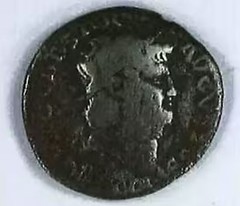 A treasure inquest has heard how three coins went missing from a 56-strong Roman coin hoard discovery, only to be mysteriously replaced with ones in better condition.
A treasure inquest has heard how three coins went missing from a 56-strong Roman coin hoard discovery, only to be mysteriously replaced with ones in better condition.
The more valuable replacements were noticed when photographs taken of the original first batch of money found did not match the currency sent to the British Museum for identification.
THE ANCIENT COINS OF POMPEY THE GREAT
Mike Markowitz published a CoinWeek article on the Ancient Coins of Pompey the Great. Here's an excerpt - see the complete article online. -Editor
ROMAN ARISTOCRAT AND general Gnaeus Pompeius (better known to English speakers as “Pompey”) was a pivotal figure in the events that led to the collapse of the Roman Republic. Coins issued in his name, or by his sons and supporters, document and illustrate a dramatic period of Roman history.
Born September 29, 106 BCE in the Italian province of Picenum, he was the son of Pompeius Strabo, a rich landowner who became a Roman senator and eventually consul in 89 BCE. At the age of 16, young Pompey accompanied his father on campaign in the Social War.
In the bloody and protracted civil wars that wracked the dying decades of the Roman republic, young Pompey sided with the dictator Sulla, raising and training an army at his own expense. In recognition of Pompey’s victories, Sulla awarded him the honorific title of Magnus (“the Great”) which appears on the coins in place of his given name. In 67 BCE, he was voted extraordinary powers to suppress the Cilician pirates, who had paralyzed Mediterranean trade and were threatening Rome’s vital imported grain supply. Public confidence in Pompey was so great that the price of bread dropped on the day he was appointed. Within three months, he swept the pirates from the seas. In 60 BCE, he formed a political alliance, the “First Triumvirate”, with Marcus Licinius Crassus, the richest man in Rome, and Gaius Julius Caesar, an ambitious up-and-coming politician. Their political enemies called it the “three-headed monster.” Pompey cemented his alliance with Julius Caesar by marrying Caesar’s daughter, Julia. Pompey was elected consul three times; in 70, 55, and 52 BCE; on the first occasion, he was not even a Senator, which was unprecedented.
PRESSBURG MINT ISSUES AI-DESIGNED BULLION COIN
A.J. Behul submitted this information on what the Pressburg Mint describes as the world’s first silver coin designed by Artificial Intelligence (AI). -Editor
The Pressburg Mint, a privately-owned mint based in Bratislava, Slovakia specializing in the production of investment gold and silver coins and bars, has issued the world’s first silver coin designed by Artificial Intelligence (AI).
AI was given the task of designing a silver coin based on what it “imagined” a silver coin should look like.
ADMIRAL WILLIAM WALDEGRAVE'S VICTORY MEDAL
Christie's recently sold a gold Victory medal issued to Napoleonic wars naval hero Admiral William Waldegrave. -Editor
The London goldsmith James Morisset is known to have made five two-colour gold boxes granting freedom of the City of London to naval heroes. Two of them are now in the National Maritime Museum in Greenwich but that issued to Admiral William Waldegrave, First Baron Radstock (1753-1825), was offered at Christie’s as part of the Exceptional Sale on July 6.
The enamelled scene to the lid of this box shows the moment Jervis in HMS Victory, closely supported by Waldegrave in the Barfleur, approached the Spanish ship Salvadore del Mundo and poured a broadside into its hull.
Additional battle scenes decorate the sides alongside the arms of the city of London, the arms of Waldegrave and the monogram WW.
FEATURED WEBSITE: THE ENGRAVED GEM
This week's Featured Web Site is The Engraved Gem.
Welcome to “the ENGRAVED GEM.com”. This site is a collection of bits and pieces of material about ENGRAVED GEMS. Most of it can be found elsewhere – that’s where it came from. In some cases it is an original compilation of or comments about the work of others. It has all been congregated in this one spot, first, as a convenient collection spot and, secondly, as a presentation to those who may be interested.


